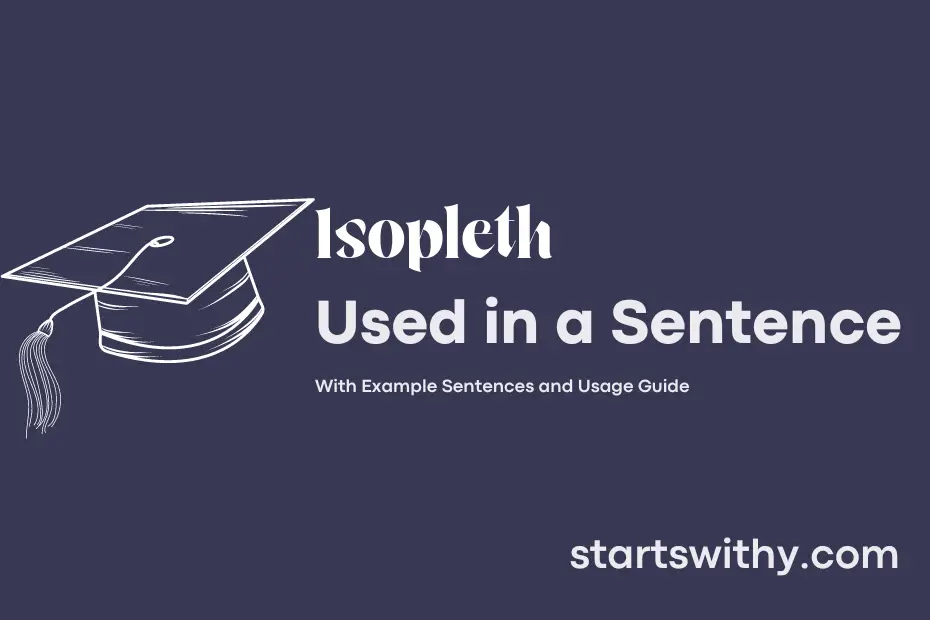Have you ever heard of an isopleth? An isopleth is a line connecting points of equal value within a geographic region, often used in mapping various data such as temperature, precipitation, or population density.
These lines offer a visual representation of the distribution of a particular variable across a given area, helping to highlight patterns, trends, and variations. By understanding isopleths, one can gain valuable insights into the spatial relationships of different factors and make informed decisions based on the depicted data.
7 Examples Of Isopleth Used In a Sentence For Kids
- Isopleth is a line showing the same value on a map.
- You can find isopleth lines on maps that show temperatures.
- Isopleth lines help us understand different levels of a certain thing.
- Let’s color the isopleth lines on this map to make it pretty!
- It’s fun to learn about isopleth lines and what they represent.
- We can use isopleth lines to see where it might be colder or warmer.
- Look, the isopleth lines on this map show us where it might rain more!
14 Sentences with Isopleth Examples
- Isopleth is used in geography to represent lines connecting points of equal atmospheric pressure.
- College students studying meteorology often use isopleth to understand weather patterns.
- Understanding how to read a isopleth map is an important skill for geography students.
- Isopleth can also be used in economics to represent lines of equal income distribution.
- Students in a statistics class might analyze data using isopleth to visualize trends.
- Isopleth can be a useful tool for students studying population density in urban planning.
- Civil engineering students may use isopleth to analyze soil samples in geotechnical studies.
- Isopleth can help biology students visualize patterns of species distribution in an ecosystem.
- Students in a water resources management class might use isopleth to map groundwater levels.
- Geology students may use isopleth to represent lines of equal elevation in a topographic map.
- Analyzing temperature data using isopleth can help students understand climatic zones.
- Isopleth is also commonly used in environmental science to map pollution levels.
- Isopleth analysis is a valuable tool for students studying the spread of diseases in epidemiology.
- Food science students might use isopleth to study patterns of food contamination in a factory setting.
How To Use Isopleth in Sentences?
Isopleth is a term used in geography and scientific research to describe a line on a map connecting points of equal value of a particular variable, such as temperature, elevation, or population density. Here is a guide on how to use Isopleth in a sentence:
-
Identify the specific variable you want to represent using an Isopleth map. For example, if you are working on a weather project, you might choose to map out temperature levels.
-
Determine the range of values for the variable you are mapping. This will help you create meaningful Isopleths that accurately represent the data.
-
Plot the data points on a map and connect points that have the same value of the variable with Isopleth lines. Make sure to label each Isopleth line with the corresponding value.
-
Use a color scheme or shading to distinguish between different Isopleths on the map. This will make it easier for viewers to interpret the data.
-
Provide a legend or key to explain the values represented by each Isopleth line on the map. This will help others understand the information you have presented.
By following these steps, you can effectively use Isopleth in a sentence and create informative maps that visually represent geographic data.
Conclusion
In conclusion, isopleths are lines on a map connecting points of equal value or quantity, often used in various fields such as meteorology, geology, and statistics to visualize continuous data patterns and trends. These lines help to simplify complex data and make it easier to interpret spatial variations.
By plotting data points on isopleth maps and connecting them with lines of equal value, researchers can quickly identify areas with similar characteristics or values. This allows for better understanding of patterns and distributions, aiding in decision-making processes in fields where spatial relationships are crucial. Isopleths help to bring clarity to data analysis, making it a powerful tool for mapping out and understanding spatial patterns in a wide range of disciplines.



